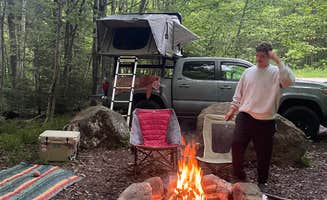Dispersed camping options near Easthampton Town, Massachusetts require careful planning due to limited availability directly in the area. The terrain consists primarily of rolling hills and mixed hardwood forests with elevations ranging from 200-400 feet above sea level. Most primitive camping sites in the region experience seasonal closures during winter months, with access roads often becoming impassable from November through April.
What to do
Fishing opportunities: Somerset VT Dispersed on the Deerfield River provides access to freshwater fishing, though recent restrictions have affected camping. "No camping signs. Private property," reports camper MaryA L., indicating that while the area may be suitable for day use, overnight stays are no longer permitted.
Hiking from camp: Hogback Mtn Trailhead offers direct trail access from a convenient overnight parking area. "Great place to stop for the night. Not a lot of ambiance, but plenty of room for any number of rigs," notes Boulder T. The paved highway pass location makes this an accessible staging point for day hikes.
Wildlife observation: Sage's Ravine along the Appalachian Trail features reliable wildlife habitat near established camping. "Near non-potable stream, no fires allowed, bathroom is fine, bear boxes available. 50 feet between platforms," explains Luke A. The bear boxes indicate regular bear activity in the area, making it important for proper food storage.
What campers like
Privacy between sites: NFR 273 Dispersed Camping Spot receives praise for its spacious layout. "At least a dozen spots, some very spacious. Only crashed for 1 night but will be coming back to spend a few, this area was excellent!" comments Michele N. Sites are positioned with natural vegetation buffers creating separation.
Fire pit construction: Campers frequently mention the quality of established fire rings at certain sites. "The spot I chose had a beautifully built fire pit. It was a little muddy from rain," shares Tam E. about George D Aiken Wilderness Dispersed. These stone rings help contain fires and reduce wildfire risk.
Water proximity: Jug End Dispersed along the Appalachian National Scenic Trail ranks highly for hikers due to its location. "Great spot, I have section hiked the majority of the east coast AT and this is in my top 10 spots to stay at," states Luke A. The location provides access to natural water sources for filtering.
What you should know
Weather-related site conditions: Seasonal rainfall significantly impacts campsite usability in this region. "Beautiful but surprisingly crowded. Many pull offs but a lot were too wet for my van and I was afraid of getting stuck," explains SJ W. about NFR 273 Dispersed Camping Spot. The road itself may remain passable while individual sites become unusable due to drainage issues.
Sanitation concerns: Some dispersed sites lack proper waste management facilities, creating potential health hazards. "Site was littered with places previous campers had left human excrement. While not in the site directly, it was all around it," reports Ricky H. about George D Aiken Wilderness Dispersed. Carrying a portable waste disposal system is strongly recommended.
Conflicting regulations: Land use status changes regularly in this region, requiring verification before setting up camp. "This is a hiking trail only- no camping per website," warns licia S. about Jug End Dispersed. Checking official land management websites prior to arrival is essential.
Tips for camping with families
Best time frames: Early fall provides optimal camping conditions with fewer insects and milder temperatures. "It was getting dark when we arrived and it had been raining all day. We just needed a night and it was great. Some sites were really wet but we found a nice dry place," shares mary about George D Aiken Wilderness Dispersed. September through early October typically offers the most reliable conditions.
Site selection strategies: Choosing higher elevation sites improves drainage during wet periods. "It had rained a lot prior to our arrival, and several sites were damp. We found a perfect site off the road on the right side. It was large and flat," advises David G. about his experience at George D Aiken Wilderness.
Insect management: Dense forest sites experience significantly higher bug pressure than open areas. "A LOT of bugs due to dense wooded surroundings. The bugs seems to be unbothered by the bug spray as well," warns Natasha T. about NFR 273. For family camping, more open sites with air movement provide better comfort.
Tips from RVers
Overnight parking alternatives: Some trailhead parking areas permit overnight stays for self-contained vehicles. "Great place to stop for the night. Not a lot of ambiance, but plenty of room for any number of rigs," notes Boulder T. about Hogback Mtn Trailhead, indicating that while not a traditional campsite, it serves well for quick overnight stops.
Road condition realities: Forest service roads require careful assessment before committing to travel with larger vehicles. "The entrance to the road had a sign that said 'road closed ahead'. We chanced it and was able to find a really nice open spot right before the road closure," reports Caitlin C. about NFR 273 Dispersed Camping Spot. Always have a backup plan when road conditions might change.


